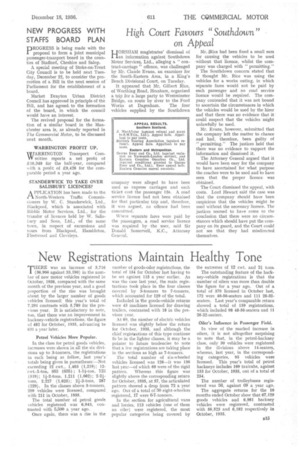New Registrations Maintain Healthy Tone
Page 49

If you've noticed an error in this article please click here to report it so we can fix it.
THERE was an increase of 3,716 I (36,906 against 33,190) in the number of new motor vehicles registered in October, 1936, compared with the same month of the previous year, and a good proportion of the rise was brought about by the larger number of goods vehicles licensed; this Year's total of 7,291 contrasts with 5,789 for the previous year. It is satisfactory to note, too, that there was an improvement in hackney-vehicle registrations, the figure. of 482 for October, 1935, advancing to 631 a year later.
Petrol Vehicles More Popular.
In the class for petrol goods vehicles, increases were shown in all the six divisions up to 3-tonners, the registrations in each being as follow, last year's totals being given in parentheses:—Not exceeding 12 cwt., 1,403 (1,219); 12 cwt.-1-ton, 883 (635) ; 723 (519); li-2-tons, 1,211 (1,062); 2-24tons, 2,227 (1,625); 23-3-tons, 287 (229). In the classes above 3-tonners, 209 vehicles were licensed, compared with 211 in October, 1935.
The total number of petrol goods vehicles registered was 6,943, contrasted with 5,500 a year ago.
Once again, there was a rise in the
number of goods-oiler registrations, the total of 154 for October last having to be set against 115 a year earlier. As was the case last year, the main registrations took place in the four classes covered by 3-tonners to 7-tonners, which accounted for 129 of the total.
Included in the goods-vehicle returns were 43 machines licensed for drawing trailers, contrasted with 18 in the previous year.
At 69, the number of electric vehicles licensed was slightly below the return for October, 1935, and although the chief registsations of this type continue fo be in the lighter classes, it may be a pointer to future tendencies to note that a few registrations are taking place in the sections as high as 7-tanners.
The total number of six-wheeled vehicles licensed was 126—it was 136 last year—of which 69 were of the rigid pattern. Whereas this figure was slightly above the corresponding return for October, 1935, at 57, the articulated pattern showed a drop from 72 a year ago. Out of a total of 30 eight-wheelers registered, 17 were 6-7-tonners.
In the section for agricultural vans and lorries, 113 vehicles (one of them an oiler) were registered, the most popular categories being covered by the extremes of 12 cwt. and 21 tons. The outstanding feature of the hackney-vehicle registrations is that the number of oilers was more than double the figure for a year ago. Out of a total of 370 licensed in October last, 172 were 48-56-seaters and 111 26-32seaters. Last year's comparable return showed a total of 159 registrations, which included 98 48-56-seaters and 11 26-32-seaters.
Oiler's Influence in Passenger Field.
In view of the marked increase in oilers, it is not altogether surprising to note that, in the petrol-hackney class, only 30 vehicles were registered in the divisions above 14-seaters, whereas, last year, in the corresponding categories, 95 vehicles were licensed. This year's total of petrol hackneys includes 169 taxicabs, against 153 for October, 1935, out of a total of 254.
The number of trolleybuses registered was 56, against 69 a year ago.
The aggregate returns for the 10 months ended October show that 69,129 goods vehicles and 6,981 hackney vehicles were registered, contrasted with 56,523 and 6,182 respectively in October, 1935.




















































































